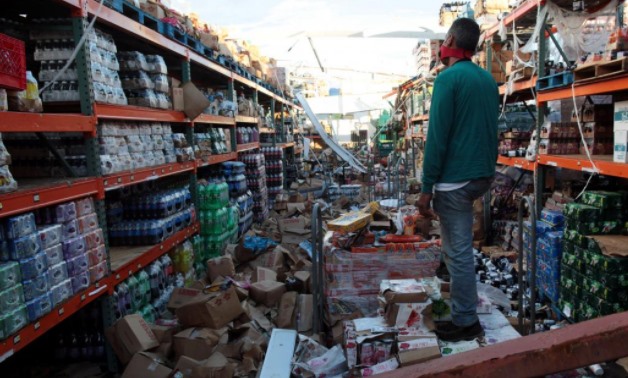
A man stands inside of a destroyed supermarket by Hurricane Maria in Salinas, Puerto Rico, September 29, 2017 – REUTERS/Alvin Baez
CAIRO – 21 October 2017: The 2017 Atlantic Hurricane Season has not only been super active, but also super unlucky; in some past busy hurricane seasons, land areas have avoided some of the most extreme storms, but this year they turned into a magnet.
Category 5 hurricanes have directly hit six land masses head on, leaving devastation in their wake almost every time. While just two separate hurricanes, Irma and Maria, did all the dirty work, they repeatedly found areas to target.
Puerto Rico nightmare: MARIA
Hurricane Maria is regarded the worst natural disaster on record in Dominica as it caused catastrophic damages and a major humanitarian crises in Puerto Rico. The tenth-most intense Atlantic hurricane on record, Maria was the thirteenth named storm, seventh consecutive hurricane, fourth major hurricane, and the second Category 5 hurricane of the unusually active 2017 Atlantic hurricane season, Wikipedia.
It has been a month since Hurricane Maria made landfall in Puerto Rico as a Category 4 storm and pummeled the island with sustained winds of 155 mph. The storm devastated Puerto Rico’s water system, power grid, road network and cellphone infrastructure; it is now responsible for at least 48 deaths.

This infrared image of Hurricane Maria shows the extent of Maria's clouds stretching from Florida to Nova Scotia, Canada - Courtesy of NASA/JPL, Ed Olsen
Highways and bridges suffered heavy damage, cutting off some towns and hampering delivery of relief supplies such as food and water. Of Puerto Rico’s 5,073 miles of road, 392 were open earlier this week (including passage on an outer ring of the island), according to the Federal Emergency Management Agency.
Maria decimated much of the island's structures, forcing 4,246 people to continue to reside in 92 shelters.
At least 76 people are still missing in Puerto Rico 30 days after Hurricane Maria made landfall on the island as a powerful Category 4 storm, officials said.
The strongest observed in the Atlantic since 2005: IRMA
The most powerful Atlantic storm in a decade has caused widespread destruction across the Caribbean and the southern US, leaving 55 people dead. Irma, at times a category five hurricane, packed winds of up to 295km/h (185mph).
The storm cut a devastating trail across Caribbean countries and territories before moving up through the U.S. states of Florida, Georgia and South Carolina, weakening into a tropical depression.
An estimated 1.2 million people have been affected.
The Tampa Bay Area felt Irma’s worst impacts overnight. As the storm moved north, winds shifted to come from the west, bringing a dangerous and storm surge with it.
On Sunday, the center of the storm made its first Florida landfall at Cudjoe Key, just east of Key West, at 9:10 a.m. The storm was crawling to the north-northwest at just eight mph at the time, but the winds were blowing at close to 130 mph.

Hurricane Irma on Its Way to the Bahamas as a Potentially Catastrophic Category 5 Hurricane - Courtesy of weather.com
The eye of Hurricane Irma made its second landfall in Florida on Sunday at 3:35 p.m., in Marco Island, south of Naples. Just prior to landfall, the Marco Island Police Department reported a 130-mph wind gust in the eyewall of the hurricane. The city of Naples experienced a 142-mph gust.
A combination of high tide and onshore wind pushed a storm surge into the low-lying city of Miami on Sunday. Winds are gusting to 90 mph at Miami International Airport.
More than five million people across Florida were ordered to evacuate and thousands are crammed into shelters.



Comments
Leave a Comment